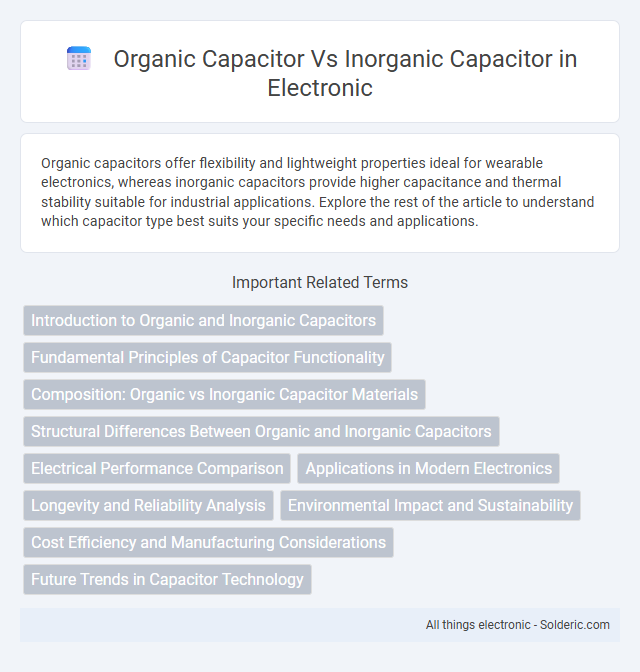Organic capacitors offer flexibility and lightweight properties ideal for wearable electronics, whereas inorganic capacitors provide higher capacitance and thermal stability suitable for industrial applications. Explore the rest of the article to understand which capacitor type best suits your specific needs and applications.
Comparison Table
| Feature | Organic Capacitor | Inorganic Capacitor |
|---|---|---|
| Dielectric Material | Organic polymers (e.g., polymer film) | Ceramics, metal oxides, glass |
| Capacitance Range | Low to medium (pF to uF) | Wide range (pF to mF) |
| Voltage Rating | Low to medium voltage | High voltage capability |
| Temperature Stability | Moderate stability (-40degC to 125degC) | High stability (up to 250degC) |
| ESR (Equivalent Series Resistance) | Lower ESR, suitable for high frequency | Higher ESR, less efficient at high frequency |
| Leakage Current | Higher leakage current | Lower leakage current |
| Applications | Signal filtering, audio circuits, timing | Power electronics, filters, high frequency |
| Cost | Generally higher cost | More cost-effective |
| Physical Size | Typically larger | Compact sizes available |
Introduction to Organic and Inorganic Capacitors
Organic capacitors use carbon-based materials such as conductive polymers or organic films as their dielectric or electrode components, offering flexibility and lightweight properties ideal for wearable electronics and flexible circuits. Inorganic capacitors utilize ceramic, mica, or metal oxide dielectrics that provide higher thermal stability, capacitance, and voltage ratings, making them suitable for high-frequency and high-power applications. Your choice between organic and inorganic capacitors depends on the specific performance characteristics like durability, frequency response, and environmental resistance required by your electronic device.
Fundamental Principles of Capacitor Functionality
Organic capacitors utilize polymer-based dielectrics that offer high dielectric constant and flexibility, enhancing charge storage efficiency and mechanical durability. Inorganic capacitors typically employ ceramic or metal oxide dielectrics, providing superior thermal stability and high dielectric strength for reliable energy storage in harsh environments. The fundamental functionality relies on the dielectric material's ability to polarize and store electric energy between conductive plates, with organic materials favoring flexibility and low ESR, while inorganic types excel in stability and capacitance density.
Composition: Organic vs Inorganic Capacitor Materials
Organic capacitors primarily use polymer-based dielectrics such as polyethylene terephthalate (PET) or polypropylene, offering flexibility and high dielectric strength. Inorganic capacitors rely on ceramic, mica, or metal oxide materials, providing superior thermal stability and higher capacitance at smaller sizes. Your choice between organic and inorganic capacitors influences performance characteristics like temperature tolerance, dielectric loss, and application suitability in electronic circuits.
Structural Differences Between Organic and Inorganic Capacitors
Organic capacitors typically use polymer films or organic materials as the dielectric layer, providing flexibility and lightweight properties, while inorganic capacitors rely on ceramic, metal oxides, or mica dielectrics that offer higher thermal stability and durability. The molecular structure of organic dielectrics allows for superior electrical insulation with reduced losses, whereas inorganic dielectrics exhibit crystalline structures that enhance capacitance and voltage tolerance. Your choice between these capacitors depends on the specific requirements for flexibility, thermal resilience, and electrical performance in your application.
Electrical Performance Comparison
Organic capacitors exhibit lower dielectric constants and higher equivalent series resistance (ESR) compared to inorganic capacitors, resulting in reduced efficiency at high frequencies. Inorganic capacitors, such as ceramic and tantalum types, offer superior electrical performance with higher capacitance stability, lower leakage currents, and better temperature tolerance. These characteristics make inorganic capacitors more suitable for high-frequency, high-voltage, and precision electronic applications.
Applications in Modern Electronics
Organic capacitors, such as those using conductive polymers, offer flexibility and lightweight properties ideal for wearable electronics and flexible displays, enhancing device adaptability and durability. Inorganic capacitors, including ceramic and tantalum types, provide high stability, temperature resistance, and capacitance density, making them essential in power management, automotive electronics, and telecommunications. Both capacitor types are critical in optimizing performance, reliability, and miniaturization in modern electronic systems.
Longevity and Reliability Analysis
Organic capacitors generally offer enhanced flexibility and environmental stability, but their longevity may be limited due to potential degradation of organic materials under high stress or temperature conditions. In contrast, inorganic capacitors boast superior reliability and extended lifespan, attributed to their robust ceramic or metal oxide dielectric layers that resist aging and wear over time. When selecting capacitors for long-term applications, your choice should weigh the organic type's adaptability against the inorganic type's proven durability to ensure optimal performance and lifespan.
Environmental Impact and Sustainability
Organic capacitors, made from biodegradable materials like cellulose or conductive polymers, typically have a lower environmental impact due to easier disposal and reduced reliance on toxic substances. Inorganic capacitors often contain metals such as tantalum or aluminum, which require extensive mining and pose greater recycling challenges, increasing their ecological footprint. Choosing organic capacitors can enhance your sustainability efforts by minimizing hazardous waste and supporting eco-friendly electronic design.
Cost Efficiency and Manufacturing Considerations
Organic capacitors generally offer lower manufacturing costs due to the use of flexible polymer dielectrics, which require simpler production processes and less energy compared to inorganic capacitors that utilize ceramic or metal oxide materials. Inorganic capacitors, while typically more expensive to produce, provide superior thermal stability and durability, justifying higher costs in applications demanding reliability and longevity. Cost efficiency for organic capacitors is enhanced by faster production rates and scalability, making them favorable for consumer electronics where high volume and low cost are critical factors.
Future Trends in Capacitor Technology
Organic capacitors, leveraging flexible, biodegradable materials, are advancing towards eco-friendly electronics with enhanced mechanical endurance and sustainability. Inorganic capacitors continue to evolve with higher energy density and thermal stability, critical for high-performance applications in electric vehicles and renewable energy systems. Future trends emphasize hybrid capacitor designs combining organic and inorganic properties to achieve optimized balance in efficiency, durability, and environmental impact.
organic capacitor vs inorganic capacitor Infographic

 solderic.com
solderic.com